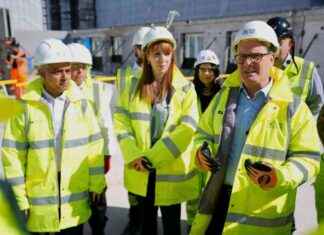The sound of a train passing at high speed. When residents talk about the night of the earthquake, it is this cry of the earth moving and cracking that they regularly refer to. Ten days after the disaster, daily life in Taroudant and the surrounding mountain villages resumed, amid the debris.
In the city center of Taroudant, dozens of families slept outside for several nights after the earthquake, for fear of an aftershock. They had barely returned to their homes when what they feared happened. On Thursday, September 14, a few minutes before 7 a.m., tremors measuring 4.6 on the Richter scale were felt. It was enough to bring out the inhabitants in the gardens and squares of the city.
Those whose homes are habitable have now returned home. “We have to come back at some point,” comments Aziz, whose children, terrified, wanted to stay in their garden.
In the commune of Tamaloukt, about twenty kilometers from Taroudant, several small villages were very hard hit. In this desolate landscape, the primary school is almost intact, which allowed students to be welcomed there from Monday September 11. The conditions are not ideal, many of them no longer have homes and must do without schoolbags, pens or notebooks for some time to come. Recovery is difficult for everyone, because you also have to confront absence. Between those who don’t have the heart to come back, the injured and of course those who will never come back again.
Some people live in tents, some families in buildings still under construction. The temporary is taking hold. For how long ? Here it starts to get cold at night and this is just the beginning: winter is coming.
If the local population was able to hold on, it was largely thanks to the outpouring of solidarity that spread throughout the country. Maria and her partner Ayoub came from Fez to be useful. The young woman is trained in first aid. Ismaël made the trip from Tangier with a group of men who transport equipment in trucks. But some places are particularly difficult to access.
Khadija, 28, points to a point in the mountainous horizon. “We’re going there,” she said. The young woman decided to go find news about a village where she has family. “Well, it’s not exactly my family, but it’s just like,” she says. To reach it, it takes around thirty minutes of walking, half of which is climbing steep slopes. Upstairs, everything is reduced to nothing, not a single house has survived. Sixteen deaths were recorded. Two days after the earthquake, the 32 survivors are in shock. What will be the future of this village?
An interministerial commission was charged with an emergency program for reconstruction. The first step consists in particular of identifying the totally or partially destroyed buildings. A titanic task since the villages are scattered over tens of kilometers in the reliefs of the High Atlas.
We will also have to agree on “how” to rebuild. Some point the finger at traditional homes, which would not have been resistant enough. Architect Salima Naji opposes this argument. In an interview given to the Moroccan media Tel Quel, she regrets the comparison made between wood, raw earth and concrete. For her, the central question is that of “architectural devices”. “Making us believe that earth is less efficient than concrete is nonsense,” she insists. And to advocate for using materials with “intelligence” and complexity.
She also warns about the timing and urgency of clearing. The rains may arrive soon, we must at all costs avoid “floods filled with rubble”.
In parallel with this project, groups of volunteer doctors and psychologists are traveling throughout the area. There are still injuries to treat, but also chronically ill people who may lack care and of course the psychological consequences of such an event. Mental health professionals also warn of the need for rapid reconstruction: what better therapy than regaining the sense of security of “home”?






